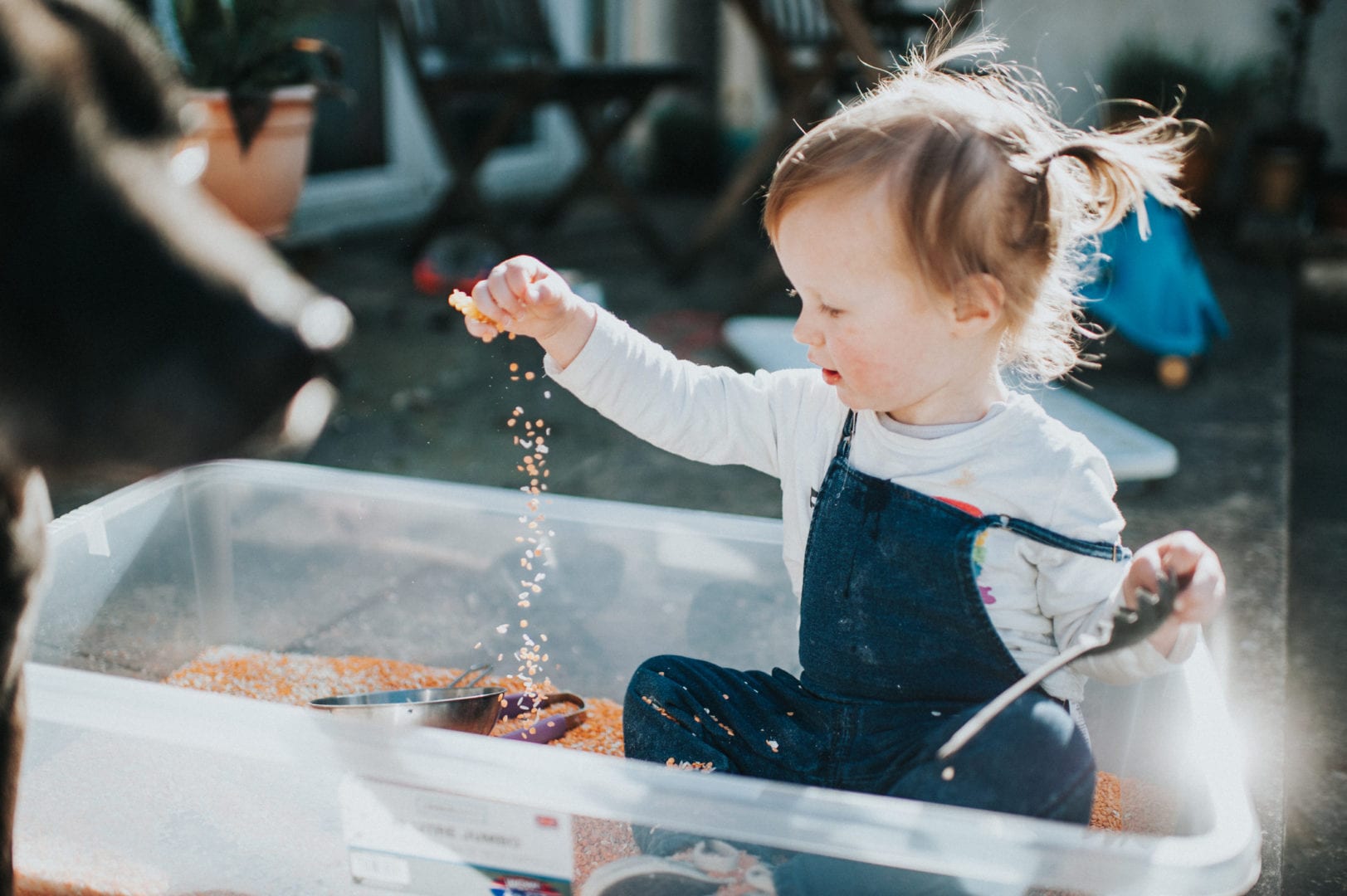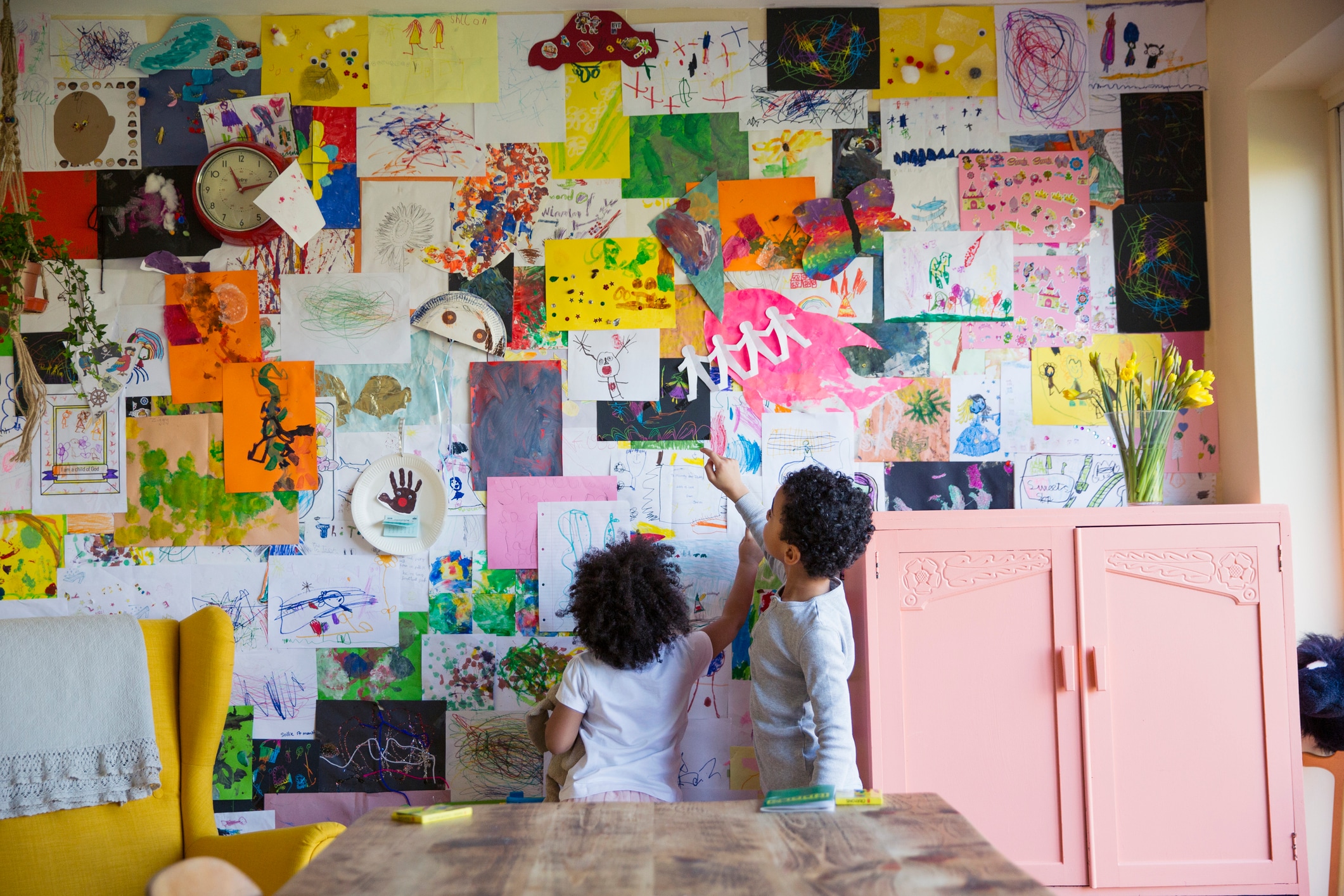Sensory activities for toddlers and preschoolers provide fun, educational and unique ways for little kids to learn about the world around them. And the good news for parents and caregivers is that there are a million ways to provide this sensory play for toddlers and few ways to do it wrong.
“Most toddlers and preschoolers naturally gravitate to sensory play,” explains Dr. Molly O’Shea, pediatrician at Birmingham Pediatrics Wellness Center, an American Academy of Pediatrics journal editor and official pediatrician of Goldfish Swim School.
She explains that we have seven senses. These include the oft-discussed five: sight, sound, touch, smell and taste. They also include proprioception, our sense of self in space, and vestibular sensation, our sense of balance. All of these can be engaged in sensory play.
Heather Aulisio, teacher and educational consultant for the parenting website Mom Loves Best, notes, “Sensory activities are vital for building nerve connections in the brain and for also introducing little hands to various textures. Sensory play helps develop fine motor skills, enhances language and has even been linked to improving picky eating habits.”
Daunted? Don’t be: Many of these require little or no prep. “There are so many simple but fun and unique ways to incorporate sensory play into the daily lives of children,” Aulisio says. Here are 16 truly fun sensory activities for toddlers.
1. Dance party

Have a dance party to encourage kids to explore sight, sound, and their sense of themselves in space all at once. Start with bright lights and loud music for one song. Then lower the lights and music volume for the next, O’Shea suggests. Alternate this for 15 minutes — about three to four songs. “Start in a darker room to maximize the effect,” she suggests. “After children become accustomed to the fun, vary the pattern.”
2. Scarf party
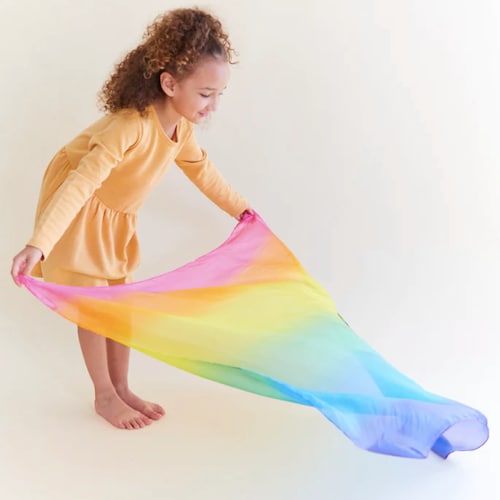
Gather some pieces of fabric of different textures and have a “scarf party” as a fun way for kids to heighten their sense of touch, O’Shea suggests. “Wear them on your head, your neck, your arms and get used to feeling the different fabric textures. Move next to scrunchies of different colors and sizes to try on as bracelets on the lower and upper arm or leg to get used to a sense of tightness.”
Where to buy: Rainbow playsilk ($22, Sarah’s Silks)
3. Spice exploration

To help kids explore their sense of smell, head to the spice cabinet and play a game of smelly or sweet. “Have kids rate spices on this rating scale,” O’Shea says. “Later have them rate the meals based on the same scale to bring taste into the equation.”
4. Taste test
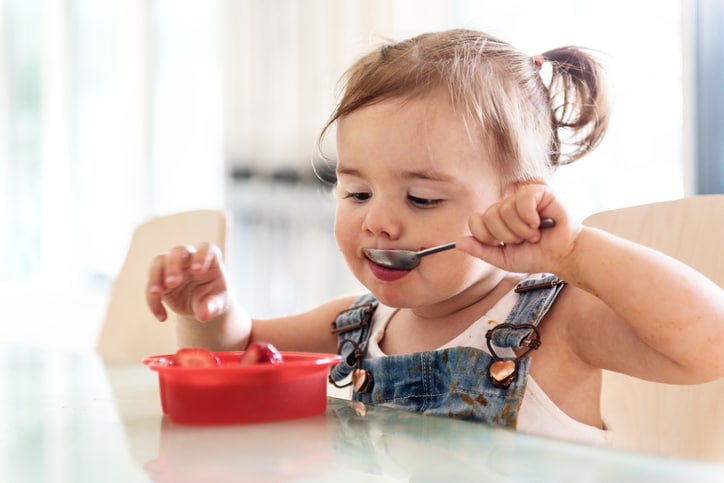
Help kids explore texture and taste with an array of food experiences. “Some kids are not interested in trying new foods at this age,” O’Shea acknowledges. As a workaround, “take the same food in the same form and offer it raw and cooked al dente and soft. This will help them explore different textures in their mouths. Offer the same food hot and cold as well,” O’Shea suggests. For more adventurous kids, try offering the same food with new sauces to broaden the child’s palate.
5. Sensory bins
Sensory bins for toddlers encourage visual and tactile exploration. To make them, you’ll just need a basket or pail, into which you’ll add materials of varied textures such as silk, fleece, sandpaper — anything you have on hand goes. “This is remarkably simple yet a fascinating sensory play idea for toddlers,” explains special needs dad Suman Chatterji, who also uses the experience as a chance to talk about the materials and sensations they’re feeling.” In this way, he says, “This kind of sensory play helps in learning by touch and sight and will also help to develop vocabulary.”
6. Hands-on gardening
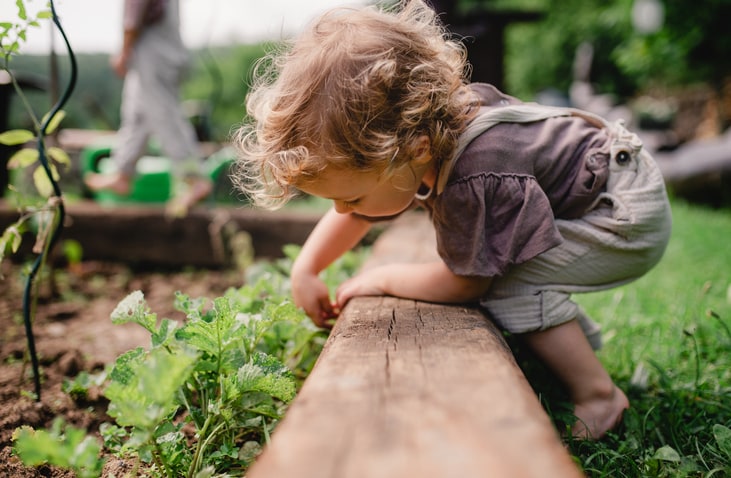
So many senses come into play with a gardening activity: the warm sun on their skin, the soft soil in their fingers and the sounds of nature. “Gardening nutrient-rich foods is our favorite activity because it’s fun for them and encourages them to eat the healthy foods that we grow,” explains Evey Rosenbloom, a happiness coach and homeschooling mom who uses a sensory-based method. She also loves the activity for the way it teaches responsibility along with sensory exploration.
7. Water transfer
Water play is arguably one of the best sensory activities for toddlers. Not only does it help hone gross and fine motor skills and develop strength in those little muscles — it’s a ton of fun! Let children scoop water from one container to the next using shovels or spoons. Turn this into a variety of games, such as having children count or predict how many scoops of water it will take to move from one container to the other. “Through this easy-to-facilitate exploration, children are learning math concepts about counting and measurement of volume. Young scientists can also observe and record their prediction and see cause and effect in their own world,” says Allison Wilson, senior director of curriculum and innovation at Stratford School.
8. Squeeze, scoop and scrub
Add an additional layer of touch to that water activity by encouraging children to squeeze, scoop and scrub using sponges, washcloths or other materials on hand. “This engages them both in fine motor development and imaginative play,” Wilson explains. “What appears to be simple movements of squeezing and scooping greatly supports the development of drawing and writing skills — great finger exercises!”
9. Bubble wrap painting
Bubble wrap has so many sensory facets: It calls upon their senses of sound, touch and sight in interesting ways. All you need for this activity is paper, paint, bubble wrap and tape. Kids use the tape to hold the bubble wrap in place on either their feet like socks or on their hands like mittens. “Put paint on the bubble wrap and enjoy!” says Justine Green, a mom, school principal and children’s book author who holds a doctorate of education. “From the popping noise to the art, it’s a great sensory activity.”
10. Mystery bag or box
Green says putting together a “mystery bag” or mystery box is a fun and easy sensory activity that exposes children to materials that are varied and interesting to the touch. Fill an opaque bag with any materials you find on hand for this activity. Think about the child’s age and what their interests are: “For an 18-month old, I’d include something smooth, something bumpy, something hard and something soft. We would talk about how the object felt in our hands,” Green explains. “For a 3-year old, I’d focus on an upcoming holiday or things we have been learning about. If we were doing a unit on fruits, then I would put a few in there like a banana, a clementine and a pear.”
11. Calming glitter jar
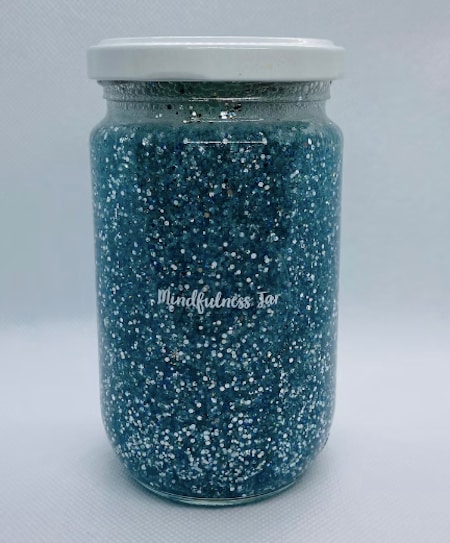
Jen McConaghie, parenting expert and founder of This Time of Mine, suggests creating a glitter jar. This project is a tactile experience to make and a visual pleasure to look at when complete. Just find an empty jar or plastic bottle and let kids decorate it. Next, fill the bottle three quarters full of water, adding clear glue, food coloring and glitter. Then seal the lid with hot glue. “Have children shake the jar and have fun watching the glitter settle,” she recommends.
Where to buy: Mindfulness jar (starting at $10.56, JustBemindfulness/Etsy)
12. Jell-O excavation
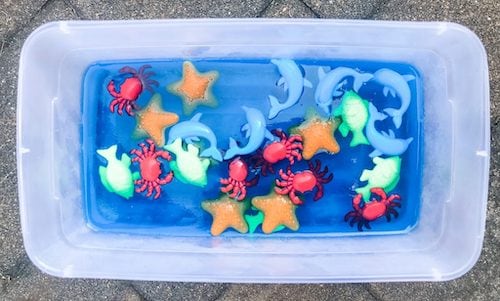
Turn a box or two of Jell-O into a fun and messy sensory experience for toddlers or preschoolers that draws upon touch, sight … and inevitably, of course, taste. “Simply mix in some toys or fun new objects, and you’ve got an exciting new activity for little ones,” notes mom and pediatric occupational therapist Marissa Labuz, who is also the founder of Teaching Littles. For inspiration, she recommends trying an ocean theme: Place dollar store ocean toys in the Jell-O before it sets and kids “will be thrilled to dig through the Jell-O to find the deep-sea creatures.”
13. Shaving cream play
“Shaving cream can be messy, but it can bring a delightful sensory experience into a child’s world,” Aulisio says, noting that it’s fun to touch, smell and see. “Spray a bit on their high chair tray or on a baking sheet and let them cut loose and get wild. Model with your own hands how they can move their fingers in circular motions, attempt to write letters or numbers or poke and prod the cream.”
14. Bubble play

One of the easiest sensory activities for toddlers? Bubbles! Bubbles can provide a unique sensory experience to see and feel: Add a few drops of food coloring to a bubble container and mix it well. Encourage kids to blow a bubble onto a piece of white paper, Aulisio suggests. When they’re done, they’ll end up with a one-of-a-kind artwork created from the marks left by these colorful popping bubbles.
15. Sensory scavenger hunt
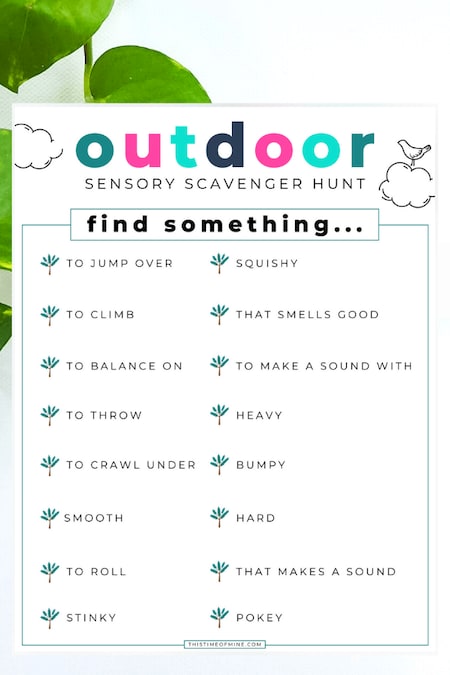
Not all sensory experiences must involve prep or cleanup. “You can turn even a walk around the neighborhood into a sensory learning opportunity,” Aulisio says. “Allow kids to pluck blades of grass, pick up sticks, search for stones, collect pine cones or even pick flowers, all of which contain different textures and stimulate senses,” including sight, touch, sound and smell. For inspiration, This Time of Mine has a free sensory scavenger hunt printable.
16. Dough rolling
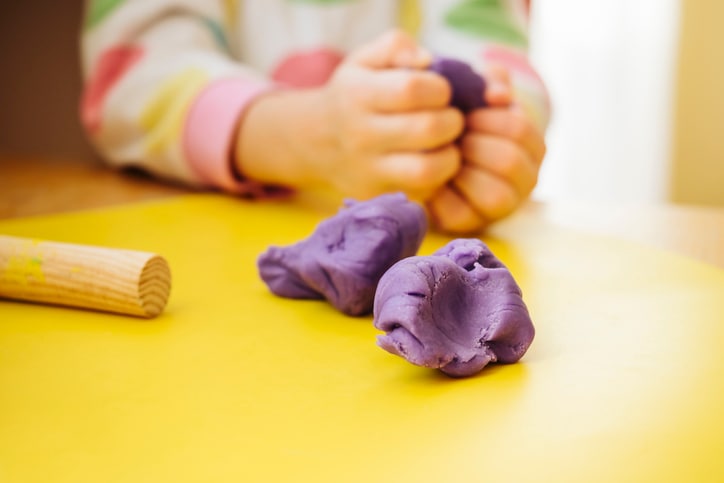
“Sand and play dough are wonderful materials to have at home to encourage sensory play,” Aulisio says. Use these materials for so many activities that encourage kids to explore their senses: “Whether you place them in molds, roll out a dough and press cookie cutters into it or just allow your child to enjoy the sensation through touch, these items are a tried-and-true favorite,” she says.
